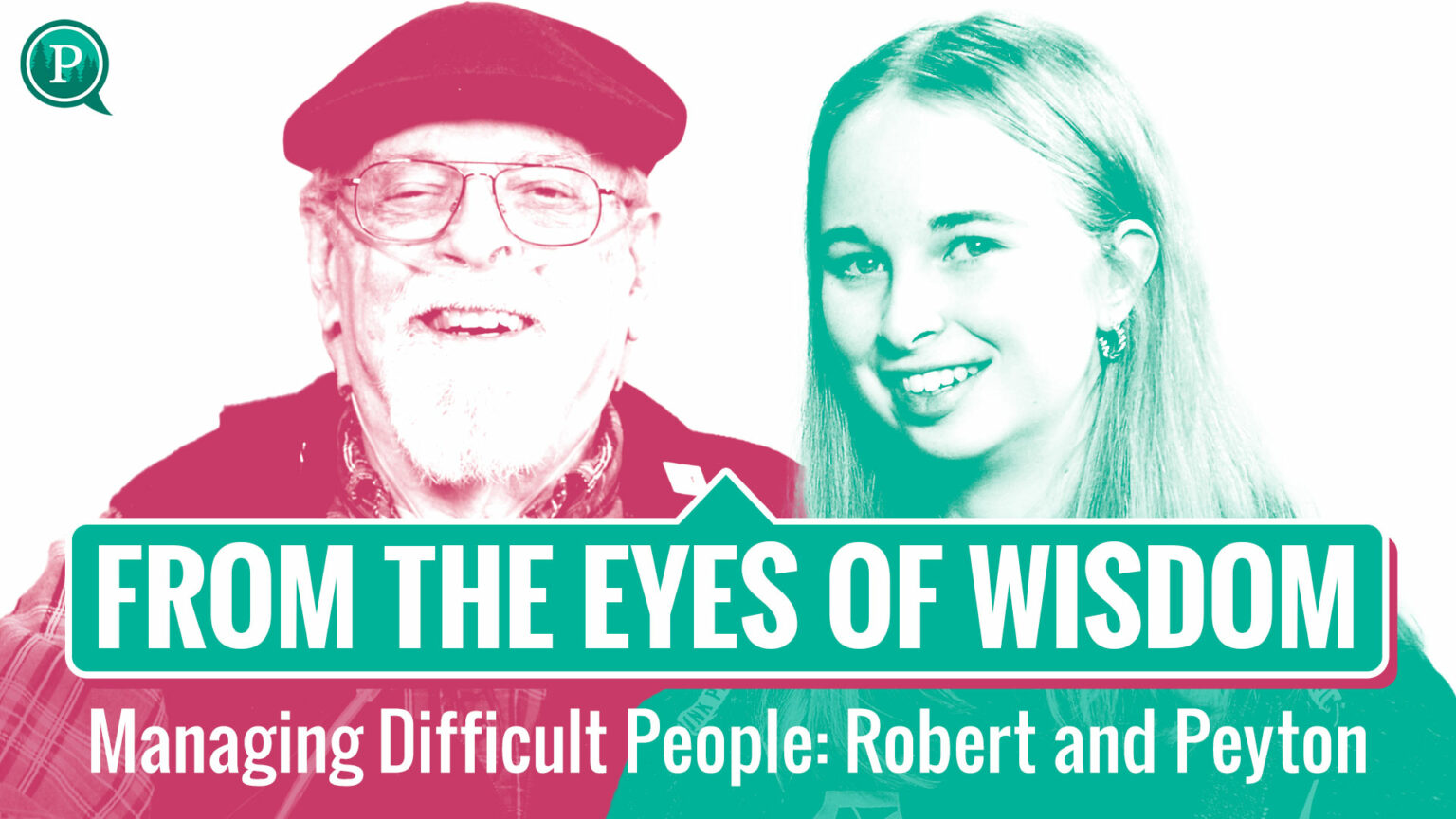Listening is always the key to better understanding and learning. Peyton and Rob discuss her love of engineering and her passion to follow down that path. Rob shares wisdom for the people she encounters along the way and how to work with difficult people. Valuable advice for each of us.
Find Out More:
CRISTA Senior Living | King’s Schools | CRISTA Media | CRISTA Ministries
Transcription:
Sherri Lynn:
Have you ever wished you could know what the future held before you got there? What if you were given the gift of knowledge before you even began your journey? Now I’ve been thinking about that because I made a lot of stupid mistakes when I was younger, and I wish I had someone to say, “Don’t go down that road. Go down this one.” I’m Sherri and welcome to From the Eyes of Wisdom where we are pairing an experienced elder from Crista Senior Living with a passionate King’s High School student ready to launch into the world. And while these conversations won’t tell the future exactly, they did reveal a lot we weren’t expecting about how to live life well. Are you ready? I can’t wait for you to hear this.
Welcome to From the Eyes of Wisdom, I’m Sherri Lynn. And here with me today we have Bob and we have Peyton. Thank you guys for joining us. Bob is, they said they didn’t mind me saying ages, so I’m going to say 83 and 17, Peyton. So Bob said we got a hundred years sitting here. We should be able to come up with some kind of wisdom from a hundred years, right?
Robert:
I hope so.
Sherri Lynn:
Okay. You would think so. I know that we are. So basically, first of all, Peyton, I want to start with you and engineering. Because when I watched your pre-interview, I could tell you were very passionate about engineering. I did not know, I will be honest with you all, I did not know there were different kinds of engineering. So I watched your pre-interview, Peyton and you’re president of the robotics club, and that’s one type of engineering and then Bob, I was watching your pre-interview and you were doing designs for bridges and other projects and that’s a different kind of engineering. Am I right?
Robert:
Yes. That’s structural engineering.
Sherri Lynn:
That’s structural engineering. You let us know the bridges you made. Bob are still standing?
Robert:
Yes.
Sherri Lynn:
All right. Okay. So different kinds of engineering, but still the same engineering as far as the vocation is concerned. So tell me why you love engineering. Tell me how you got into it. Just where did that love come from?
Peyton:
Yeah, so I’ve always loved Legos. That’s kind of [inaudible 00:02:22] start.
Sherri Lynn:
I want to say I’m weird about business podcasts. I love business podcasts like how things started. There is a podcast about Legos that you might want to get into.
Peyton:
Yeah, I’ll look into that.
Sherri Lynn:
It’s called Business Movers and it talks about how Lego started and goes all the way out. You might want to check that out. That’s it. That’s a free plug for that podcast. But I’m really into it and I just listened to the Legos one. That’s what made me… Go ahead. All right, so you would build, what would you do? Would you get the Legos? Because Legos stressed me out. As soon as I started, I’d be like, forget the whole thing and put them back in the bucket. You would dump them. Then there’s a picture of something on the bucket, right?
Peyton:
Yeah.
Sherri Lynn:
And you would build that?
Peyton:
Yeah.
Sherri Lynn:
You would build it.
Peyton:
Yeah.
Sherri Lynn:
She’s like, of course. Of course I would. Would you get frustrated by it? You loved it. Would you just keep at it until you got it done or?
Peyton:
Yeah, so stickers are the one thing that always stressed me out because I want them to be right on there. But also getting some really small pieces off of the other small pieces that’s just horrible.
Sherri Lynn:
Very stressful. Legos are very stressful for me, but I’m interested in, you would just build it. You would look and say, I love that. I want to build that. How young did you start?
Peyton:
Oh, I don’t know. Probably elementary school, like kindergarten.
Sherri Lynn:
And you love doing it?
Peyton:
Yeah.
Sherri Lynn:
Okay. You can be honest, I know seventeen may not be that cool to say it, do you still play with Legos?
Peyton:
I’d still like to build them. I don’t know about playing with them.
Sherri Lynn:
Well, it’s playing Peyton. You don’t want to use the word play. You’re still playing with Legos. That’s okay. Yes. There’s nothing wrong with that. So you still enjoy that?
Peyton:
Yeah, I have sets in my room. I have the Starry Night set and I have some flower Legos in my room.
Sherri Lynn:
Okay. All right. And so now you have been a part of the robotics club?
Peyton:
I am.
Sherri Lynn:
Tell me what the robotics club does.
Peyton:
Yeah. So in January we’re a part of First Robotics Competition. So it’s FRC.
Sherri Lynn:
You build a robot.
Peyton:
We do build a robot. So in January we get our game. And so we have to build a robot in eight weeks to play that game. And then we go to competitions, compete against the other robots and see if we can win.
Sherri Lynn:
Bob. They out here building robots and playing.
Robert:
Sounds like fun.
Sherri Lynn:
Yeah, it does. Did you know that was going on?
Robert:
I did.
Sherri Lynn:
You did?
Robert:
I’m involved in Boy Scouts.
Sherri Lynn:
Okay.
Robert:
And at least a couple of our leaders have been involved in robotics.
Sherri Lynn:
Okay.
Robert:
And the excuse if they can’t come to a scout, do some kind of a scout event or whatever, “Well, I got to do robotics with my son,” or whatever. So yeah, I’ve been aware that it’s going on.
Sherri Lynn:
Okay. Looks like people are really passionate about it.
Robert:
Yeah. Sounds like it to me.
Sherri Lynn:
Now, let’s talk about you in engineering, because I get it from your interview you weren’t passionate about engineering. You weren’t like, “Hey, I’m going to go into engineering.”
Robert:
I guess I sort of come from a long line of engineers. My great-grandfather was an engineer. My grandfather was an architect. My father was a designer. And the difference between the designer is it means he doesn’t have a degree. He knows how to design, but they call them designers rather than engineers. And I have a brother that’s also an engineer. It’s sort of in the blood, I think, more than anything else.
Sherri Lynn:
Absolutely. With all those engineers, did you think that that’s what you were going to do?
Robert:
No. My original intent when I was in college was to make the Navy a career, and I had applied for a appointment at the Naval Academy and my grades weren’t good enough for something anyway. I failed to get the appointment. So I decided to go to military college in South Carolina called the Citadel. What puzzles me is why I chose engineering as a major because I could have gotten a commission even with a history major or English major or anything like that, all they wanted was a college degree. So to this day, I don’t know why I chose engineering, which is probably the hardest curriculum on campus.
Sherri Lynn:
But do you feel like, if I asked you do you love what you do in engineering, because you still work, right?
Robert:
I do.
Sherri Lynn:
Yeah. Do you love it? Would you say? Yes, I love it.
Robert:
I still enjoy it. Yeah.
Sherri Lynn:
Okay. Still working at 83, you’re doing it because you love it. You don’t have to.
Robert:
No.
Sherri Lynn:
How long do you think you’ll work?
Robert:
I don’t know until they tell me to go home, I guess.
Sherri Lynn:
They’re like, [inaudible 00:06:49] “All right, Bob, get out of here already.” Do you feel like you love engineering that much?
Peyton:
I think I do. Yeah. I’d love to do it as long as I could.
Sherri Lynn:
Really. So 83, you could still see yourself doing stuff?
Peyton:
Yeah I could.
Sherri Lynn:
Where do you see yourself down the road?
Peyton:
I mean, I want to go to college, of course, for engineering. My dream down the road would be actually to work on military planes, but any planes. I would love to work on any planes, like commercial planes.
Sherri Lynn:
Okay. All right. So Bob, you start working in engineering. So would you call what you do design, even though-?
Robert:
Not now, no, I do project management right now.
Sherri Lynn:
Okay.
Robert:
Actually I ended up as construction manager for the city of Linwood. So I did supervise or manage quite a bit of construction over my career.
Sherri Lynn:
I would love to talk about that because beyond engineering or maybe included in engineering, so I was listening to some of your story, you had a lot of the engineering in the design, and then it sounded like you went into project management. And so you’re the president of the robotics club, feels like you have a leader personality, so you’re probably going to be a leader in a lot of different things. I’m wondering what wisdom you would give her about management and leading. Well, first of all, is management something you enjoy?
Robert:
To some degree, yes. What I do usually involves an argument with a contractor.
Sherri Lynn:
All right.
Robert:
And as such, then you’ve got to know the contract that you’re dealing with. Here’s what you signed, here’s what we agreed you were going to do. So you’ve got to know what’s in the contract and what the contractor agreed to do. So over the years I’ve accumulated that knowledge. We deal with little books about that fix called the Standard Specifications for Road Bridge and Municipal Structures, which is published by the Department of Transportation. That’s called a standard specification and it provides a standard that most contractors are used to.
Sherri Lynn:
So let’s say, I want to give you Peyton, a little background and a little foundation and wisdom because you love what you do and I think that’s a blessing. I was blessed to know I wanted to do this when I was growing up. And so when you know what you want to do and you have that laser focus. One thing that can not derail it, but can demoralize you quite frankly are people, right? Interactions with people.
Well, let me ask you this. As a leader in a robotics club, we don’t have to say any names just in case the robotics club is watching or listening to the podcast, have you come up against, hmm this person is difficult to deal with.
Peyton:
Yes.
Sherri Lynn:
You’re clenching your hands tight, so you have dealt with that. Okay, so I’m going to go back to Bob. Here’s Mr. Contractor and he’s like, “Hey Bob, I’m building this and this is what I’m doing,” and it’s not in the book and it’s wrong. How does Bob handle Mr. Contractor who’s saying, “This is what I’ve decided to do,” and it’s wrong?
Robert:
I would hear him out first and then explain to him where he was off the rails as it were, where it said in contract you got to do it this way. So you got to know your contract in order to be able to do that. I’ve dealt with those standard specifications for probably most of my 30 years as a project manager off and on, so they don’t change. So they’re pretty standard and say, okay, why is this a better way to do it than that? And hear him out, try and find out why he wants to do it differently to what the contract is. And if it’s a good way of doing it and it doesn’t degrade the work that has to be done, then sometimes you can allow them to do that. But you have to know what your objective is, which is a quality project, safe project, and understand then what his proposed fix is, call it a fix for lack of… what his proposed fix is and how would it affect the project, whether it would be… That’s kind of where the engineering comes into it, I guess.
Sherri Lynn:
This is good. This is good wisdom Peyton, even with the robotics club, the people you’re dealing with now. Because what I hear you saying, Bob, is you have to listen first. Why do you think this is a better way than what we’ve been doing? And then you have to know your stuff.
Robert:
Then you have to evaluate.
Sherri Lynn:
Okay. That’s fair. That is really, really good. I’m assuming in this kind of… Because in my vocation it’s creative, you can make anything up anytime, who cares? But in yours, one inch off, one thing wrong, the robot’s going to collapse, the bridge is going to collapse. The specifics matter. And so to be able to hear someone out, I’m guessing that’s the wisdom that I want to be able to give her from you all the years that you have been doing this of how do you deal with people? Is there a specific instance that you remember where it was like, this is a difficult person, but we’re going to have to work this out because well, we’re going to have to work it out, we’re going to make it work.
Robert:
Well, it was a paving contract in Linwood, and there were two portions to it. Part of the work was here, part of the work was over here. Several of the bid items are what they call lump sum bid items where you bid a scope of work that’s outlined in the contract, just as for instance, traffic control, you’ve seen little flaggers out with their flags directing traffic, right? And we usually pay for that as a lump sum. So a contractor may have bid $10,000 for the whole contract. So because of circumstances, we had to cancel part of the contract. And so the question then we sat down with the contractor and had a negotiation. He wanted traffic control, he may have had say, $10,000 for the whole contract. He’d say, well, 5,000 for this half, 5,000 for this half. And he had something different. I don’t remember what it was off the top of my head right now.
But say you had $6,000 over here and $4,000 over here. Why the difference? Hear him out. Why do you believe it was going to cost more money to do the traffic control here than over here? So hear him out. I had the advantage, the contract specifications, the contract that he signed allowed us to have his paperwork of how he arrived at his bid for this. So I had kind of an inside track. I knew what he was… And so maybe you gave him $50 more or something like that. But you give them a little bit. So it’s strictly a negotiation this sort of thing,
Sherri Lynn:
You have to know your stuff. You have to have your stuff in the hand and listen and hear a person out. Even if the personalities are hard to deal with, I’m guessing.
Robert:
Oh, actually this guy wasn’t too bad to deal with. The superintendent wasn’t and he started blathering off about something.
Sherri Lynn:
How do you handle the blather, Bob?
Robert:
His boss was in the room and I said, “Okay, let’s take a break. You guys can talk it out. We’ll leave the room, talk it out, come to a conclusion, we’ll come back and then we’ll finalize.” Anything, treat somebody like you, like to be treated. Do unto others, so on and so forth. But I’ve also found in my career that if you treat a contractor like you’d like to be treated, that in the end he’ll probably come around and they kind of get the message. Say, okay, he’s going to be fair with me. I’ll be fair with him.
Sherri Lynn:
Tempers and passions can run kind of high, especially if you’re building something together. Do you like collaborative work or would you rather be a person who kind of builds on their own. Collaborative, you know what I mean? Everybody working together. What do you prefer?
Peyton:
If we’re designing something, I love the collaboration because I might not think of something that’s really important. And that’s just for the part that I do for robotics. I use the big machines and cut metal. I like to do that by myself because it’s just I need to get the design right and have the measurements right. And I think it’s easier for me to do it myself. But then when we get to building the robot, I love doing it with everybody else. Maybe they might be like, oh, let’s move this piece over here. Let’s switch it up a little bit. And I think that’s great.
Sherri Lynn:
So collaborative is great, but you’re dealing with humans. Humans have personalities. Humans have attitudes. Humans have emotions. Humans have thoughts and feelings. You don’t have to mention any names. Has there been a time where you’re like, okay, that you’re giving a little too much. You know what I mean? We’re doing something here, but you’re swerving into something else. Have you ever felt that?
Peyton:
Yeah.
Sherri Lynn:
You have. And how have you dealt with it whether you feel like you dealt with it right or wrong?
Peyton:
I mean, it’s got to take some deep breaths. I’ve had something like this happen just last year. And so it’s just like, okay, I’ve done all of that I can, I think where I am is great. If this other person thinks that they need to do more, then that’s fine for them and we can bring it up with our adult coach.
Sherri Lynn:
Okay. All right. So that’s good. Where you’re like, I’ve done what I can do. Which kind of goes back to what you’re saying, Bob is like, okay, I’ve shown you, here’s the issue. Then you go like you told the supervisor, why don’t you guys go talk that out and come back to us? Because dealing with difficult people, the wisdom that I hear you giving is, Hey, they’re going to be there. But if you can listen and treat people with respect, especially in this field where it matters, little tiny things matter. An inch off, a degree off, means that robot’s not going to work. Am I right?
Peyton:
Yes.
Sherri Lynn:
I don’t know, because I’m terrible at math or whatever. But one degree off means it’s not going to work. One degree off means this bridge is not going to stand. So we do have to come to-
Robert:
There was a famous case where they were building a railroad line, and every project usually has a reference line. So the rails met like this because somebody misread the plans.
Sherri Lynn:
It matters. So we do have to get this right, but how do I deal with someone in a way that the relationship or the working relationship, we can maintain some level of cordialness amongst us and it doesn’t have to be tense, right? Like that tension. Can you show us some of your drawings, Bob? Well, we’d love to see some of the stuff you’ve designed.
Robert:
This is long ago and far away.
Sherri Lynn:
Okay. This is good. And these still standing Peyton? The stuff is still standing. Wow. I’m amazed.
Robert:
I drew every one of these too, by the way.
Sherri Lynn:
Were you good at math in school?
Robert:
Yes.
Sherri Lynn:
Like geometry and all that?
Robert:
Yeah. I took four years.
Sherri Lynn:
Oh, you were fantastic [inaudible 00:18:18].
Robert:
I going to say, if you haven’t taken four years of math in school…
Sherri Lynn:
And I’m guessing you’re wonderful at math Peyton?
Peyton:
Up to calculus BC-
Sherri Lynn:
Of course you are.
Peyton:
… at this point.
Robert:
Well, I had algebra one, [inaudible 00:18:30] geometry, algebra two. In my senior year in high school I had combination of solid geometry and trigonometry.
Sherri Lynn:
Wow.
Robert:
So then I got to college and met calculus.
Sherri Lynn:
How’d you feel about that calculus that you met?
Robert:
I flunked it almost.
Sherri Lynn:
Didn’t appreciate it, huh?
Robert:
Yeah.
Sherri Lynn:
Look at that.
Robert:
I could not figure it. Well, this is a deck for a concrete-
Sherri Lynn:
I’m going to lift this up so the camera can see it like that. And go ahead and they don’t need to see me. Look at that. What are we looking at, Bob?
Robert:
You’re looking at the deck for a pre-stressed girder bridge.
Sherri Lynn:
Sorry for the podcast listeners, but it’s beautiful. Go to YouTube. Go ahead.
Robert:
These are pretty standard bridges throughout Washington state. They pretty well standardized the box girders. And you have to design the slab and you have to design the box girders. I mean the pre-stressed girders as well.
Sherri Lynn:
You drew this Bob. So by hand you drew this.
Robert:
I personally drew that. Yes.
Sherri Lynn:
You personally drew this. Peyton, do you do stuff like this for robots?
Peyton:
We do have a design team that designs like that. We do it online, but it’s very similar.
Sherri Lynn:
Yeah. But by hand, many of your friends do this?
Peyton:
No.
Sherri Lynn:
No, they can’t, Bob. No, they can’t. They don’t make them like this anymore.
Robert:
They don’t do that anymore. They have what they call CAD now. Computer-Assisted Drawing.
Sherri Lynn:
What does that mean?
Robert:
Computer-Assisted Drafting.
Sherri Lynn:
Oh, so they draw it by computer.
Peyton:
Yeah.
Sherri Lynn:
Okay. So nobody’s going by hand and just [inaudible 00:19:54].
Robert:
Nobody’s doing it by pencil and two triangles and a T-square anymore.
Sherri Lynn:
I think they should because look at that. That’s amazing. What’s the most rewarding part of your job, Bob? All the years you’ve been doing it.
Robert:
Getting a job completed, getting some recognition for doing a reasonably good job.
Sherri Lynn:
While he’s doing that, are there any questions you have for Bob? I don’t want to monopolize. Anything that you think, wow, I’d love some wisdom on this or that? Go ahead.
Peyton:
Oh, I don’t know. I think it’s really great hearing about people, conversations that you have to have.
Robert:
Well, this is probably a lost art, just drafting. I mean, all this stuff I just looked, this is a pier for a bridge.
Sherri Lynn:
I’m going to hold it up so people can see it. So Bob, someone says to you, “We want a pier for a bridge.” That’s what they say. And you go and do this.
Robert:
Well, first off, you have to decide, it’s more than just that, you got determine the parameters for the bridge and what the span lengths are. Normally you start off a bridge project by doing a geotechnical survey of the site of the bridge, which is going out, they take borings, they find out what soil’s down below.
Sherri Lynn:
Is that the guys with the orange vests and they have a little triangle thing that they’re looking through.
Robert:
No that’s-
Sherri Lynn:
Not anything. Okay, nevermind.
Robert:
Well, that’s the survey crew.
Sherri Lynn:
That’s the survey guys. Okay.
Robert:
But no, these are the guys that have the drill, the trucks with the big drills on the back of them, and they’re taking cores to find out what the underlying soils are.
Sherri Lynn:
How long did it take you to do that? To do the drawing?
Robert:
Draw that?
Sherri Lynn:
Yeah.
Robert:
I don’t know. I don’t remember this particularly but to do the drawing probably two or three days.
Sherri Lynn:
Two or three days. You have friends who do the design of the robot first?
Peyton:
Yes.
Sherri Lynn:
If you said to them, “Guess what guys, sorry to tell you…” Is it CAD?
Robert:
Yeah. Computer Assisted Drafting.
Sherri Lynn:
Yeah. … “the CAD is broke and it’s never going to work again. You’re going to have to design this by hand like Mr. Bob did. So go ahead and do that.” You’re laughing already. Never going to happen.
Peyton:
No.
Sherri Lynn:
You’re not going to have a robot, are you? They’re not going to. Okay. So they can’t do that anymore. So, well, I mean, I love the fact that it is something that you can do in solitary, meaning whether you’re cutting the metal or you’re making the design or collaborative, project manager and you’re making the robot together and learning how to deal with people, talk to people, deal with difficult personalities because you have to get something done and it has to be done in a very specific way. And I think at your age, if you can learn that from Bob, learn from beginning to end.
Robert:
It sounds trite. There’s a reason why you got two ears and only one mouth.
Sherri Lynn:
It is. And I am guessing it’s hard when you hear someone, especially when you know that book you were talking about, you know all those specifications and you’re talking with someone and it’s clear they don’t.
Robert:
Yeah,
Sherri Lynn:
I think it would be difficult. It would be difficult for me to not be like, no, this, this, this, this. But to actually hear them out, like you said.
Robert:
Well, usually you end up writing them a letter.
Sherri Lynn:
Ah, okay.
Robert:
I got very good at writing a letter, what I call nasty grams. Dear sir. It’s come to my attention that you are not in compliance with section so-and-so standards specification.
Sherri Lynn:
Yeah, okay. Nasty grams, Peyton. All right, there you go.
Peyton:
I’ll remember that.
Sherri Lynn:
Some robotics people going to get some nasty grams. Bob, I want you to think about all that you’ve been through, all the different projects, all the different design things, everything you’ve done. Peyton is launching off into engineering. This is her senior year. She’s going to go to college for this. Is there one piece of advice? It could be about engineering, it could be about life in general. Is there one piece of advice you would give her? She has a pen here. She has a piece of paper here. She’s going to write it down. One piece of advice that she’s going to take with her throughout life. She’s going to keep going back to this piece of paper. And remember Bob said this. Is there a piece of advice you would have for her that she needs just to remember for life?
Robert:
Yeah. Really treat everybody like you’d like to be treated. Don’t bad mouth them. Don’t degrade them because they come up with what sounds like a silly idea. Really treat them like you’d like to be treated. I’ve found that’s been more successful. I’ve had to deal with contractors. I’ve had to learn how to deal with architects, had to learn how to deal with other engineers. Usually, particularly with architects, there’s a lot of ego involved.
Sherri Lynn:
I bet.
Robert:
And some other engineers, there’s ego involved. So you just got to be careful not to step on them, I guess is what.
Sherri Lynn:
How do you do that, Bob? Not step on the ego, but still get what you need done done.
Robert:
Hear them out. But sometimes you say, okay, I understand what you’re saying. I don’t think it’s going to work. Contract says, you got to do it this way. We’ve hired good design engineers to design it that way. There’s a reason why it’s designed that way, so we’ll build it the way it says on the plans, and if you have to tear it out, that’s your problem.
Sherri Lynn:
Yeah. That’s tough. Ego. Getting to the ego is-
Robert:
It’s not getting to the ego.
Sherri Lynn:
Yeah. Any other questions you have, Peyton?
Peyton:
I don’t think I have any. This is great.
Sherri Lynn:
Wonderful. Well guys, this was great. Thank you so much. You’ve been [inaudible 00:25:27].
Robert:
I’ll give you something else you’ll probably never use either.
Sherri Lynn:
Oh?
Robert:
You know what that is.
Peyton:
I don’t.
Robert:
That’s a slide rule.
Sherri Lynn:
Really?
Robert:
You’ve probably heard of them.
Peyton:
I have heard of them.
Robert:
You’ve heard of logarithms, haven’t you?
Peyton:
Yep.
Robert:
So you understand logarithms?
Peyton:
Sometimes.
Sherri Lynn:
Oh boy. I wish [inaudible 00:25:47].
Robert:
That’s basically doing multiplication by logarithm.
Peyton:
Wow.
Robert:
In fact, most of the bridges that I designed-
Sherri Lynn:
You designed with that?
Robert:
Designed with that. Yeah.
Sherri Lynn:
Can I see it?
Peyton:
Yeah.
Sherri Lynn:
You designed most of the bridges you designed with this?
Robert:
Yes.
Sherri Lynn:
It’s a ruler, but it slides.
Robert:
Oh, it’s called a slide rule.
Sherri Lynn:
A slide rule. Oh, look at this. Okay. Well, we’re going to close out while I play with this rule. Thank you so much for tuning into From the Eyes of Wisdom. I’m going to go and look at this slide rule because the middle slides, guys, did you see that? Look at that. Bob, you made all those drawings with this.
Robert:
No, no. Not the drawings.
Sherri Lynn:
Not the drawings.
Robert:
Just the calculations for the drawings.
Sherri Lynn:
The calcu…
Robert:
Everything has to be… Well, let me dig into my briefcase right now.
Sherri Lynn:
Everything has to be calculated before you draw. Bob’s going to tell me more. We’re going to go off here and we’re going to have another, because I didn’t know you had to calculate first and then draw. Thank you for joining us on From the Eyes of Wisdom. We’re going to keep going into this.







